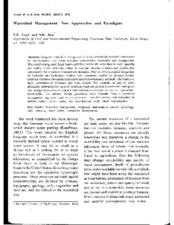| dc.description.abstract | Integrated watershed management is being increasingly accepted now-a-days for environmental and water resources conservation, protection and management. Watershed management links human activities within the watershed to water quantity and quality of the receiving stream or lake and requires mathematical models that can quantify the impacts of management strategies. They involve conceptual integration of hydraulic and hydrologic models with concurrent models of physical habitat, chemical transport, biological populations and socio-economic, political, administrative, legal, government, financial, and other models. For example, in case of water allocation, estimating the value of in-stream water use permits recreational, ecological, and biological concerns to compete with traditional consumptive uses, i.e., agriculture, municipality, and industry, energy generation, waste disposal. Thus, a watershed management approach must be comprehensive, interdisciplinary, and integrated to address today's needs, taking into consideration likely future repercussions. | en |


